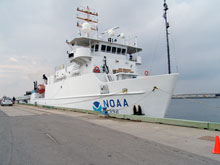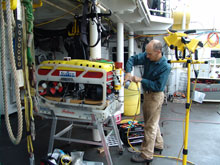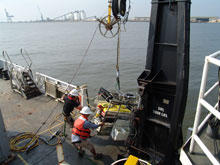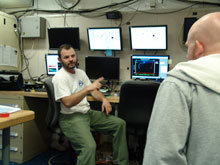The NOAA Ship Nancy Foster sits ready and waiting before departure from Gulfport, Mississippi. Click image for larger view and image credit.
Before leaving port, the ROV was taken for a test run. Here, Matthew Cook, operations manager for SeaView Systems Inc., preps the ROV for launch. Click image for larger view and image credit.
New Adventures on Inexperienced Sea Legs
September 20, 2008
Leslie Wickes
Research Technician
Temple University
Matt Porter
Student
The Pennsylvania State University
Jay Lunden
Graduate Student
Temple University
No sooner after we left port did the waves begin to gently sway the boat and then also begin to churn our stomachs. With sea legs yet-to-be-acquired, much of the day for the newest travelers out-to-sea was spent in the darkest room below deck fighting off seasickness. Despite the unfortunate result of the choppy water, the beginning of the day was filled with the excitement of saying goodbye to land and watching the crew busily prepare to leave.
As we stood on deck preparing to leave port, we were given the opportunity to watch the remotely operated vehicle (ROV) make a test dive off the side of the ship. After being deployed by a large winch, the pilots expertly maneuvered the ROV out of its protective container, called the “garage,” and around the side of the ship. Following this 10-minute excursion, the ROV was driven back into its garage and brought back on deck, and the ship was quickly underway.
The rest of the day was spent participating in scientific meetings, safety briefings, and fire and abandon-ship safety drills. For our abandon-ship drill, we were required to arrive at our assigned safety boat with a life preserver, hat, long-sleeved shirt, and a floating survival suit, also called a “Gumby suit.” The crew mimicked standard procedures, making sure we would be adequately prepared in the event of a “real” emergency.
Erik Cordes, chief scientist for the Lophelia II 2008: Deepwater Coral Expedition: Reefs, Rigs, and Wrecks exploration, explains a profile collected by a conductivity-temperature-depth (CTD) meter. The CTD meter will be used to collect data such as temperature and oxygen as a function of depth. Click image for larger view and image credit.
After learning about our responsibilities during an emergency situation, we were taught the methodology that will be used to record observations during ROV dives. In the coming days, during the 12 hours the ROV is deployed, we will be taking shifts to watch live feed of video footage.
We will be exploring sites never seen before and hope to encounter new and exciting marine life.
Sign up for the Ocean Explorer E-mail Update List.

























